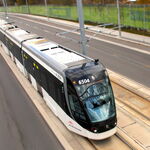jje1000
Senior Member
So what's next? I suppose the next major thing to look forward to is either more Metrolinx board meetings, or the release of the RFPs for electrification per line?
Yeah you do. Operating costs for that level of service are significantly lower with electrification. The payback is between 5 and 7 years; so it interests anyone who has mentioned high taxes, high fares, noise, clean air, or even the speed of the trip.
Trackwork to support 15 minute frequencies is another item but that happens regardless of the power plant location (on train or fixed location).
it's not per line, it's one RFP for everythingSo what's next? I suppose the next major thing to look forward to is either more Metrolinx board meetings, or the release of the RFPs for electrification per line?
If it is truly the case that there is a 5-7 year payback then we will have private investors fighting for this project. So no provincial funding needed for electrification.
...Or the report was a bunch of b.s. to please the political masters at the time
Yep. If the track was in place with a commitment by the province to maintain the track, stations, and trains; private industry would pay quite a bit for a 30 year term to collect fares (todays level + annual inflation increases) and operate GO service; contingent on electrification being allowed.
"look to the private sector to propose innovative approaches to meet future GO Transit rail service levels".
To me it reads that the province no longer funds electrification.
I read it the opposite. It appears that they are proceeding with the MOADBFOM RFP - which always left it to the bidders to propose electrification, hydrail, or not.
The buildup puffery certainly led us to believe we would hear more.
I suppose the next major thing to look forward to is either more Metrolinx board meetings, or the release of the RFPs for electrification per line?
I can't say I'm at all surprised. The writing has been on the wall for some time, even beyond DBFOM, Verster has been saying (gist)"It's up to the winning bidder" as to method of propulsion, rolling stock type, etc.it's not per line, it's one RFP for everything
The OECD's annual Revenue Statistics report found that the tax-to-GDP ratio in Canada decreased by 0.5 percentage points, from 32.7% in 2016 to 32.2% in 2017. The corresponding figures for the OECD average were an increase of 0.2 percentage points from 34.0% to 34.2% over the same period.
Revenue Statistics 2018 - Canada - OECD.org
https://www.oecd.org/tax/revenue-statistics-canada.pdf
Web results
Canadians' tax burden is among the lowest in OECD, report says - The ...
https://www.theglobeandmail.com/.../article-canadians-tax-burden-is-among-the-lowes...
1 day ago - The average single worker in Canada paid 23 per cent of their gross wages in taxes last year after cash benefits, ranking 26th lowest in 2018.
https://www.theglobeandmail.com/bus...rden-is-among-the-lowest-in-oecd-report-says/BARRIE MCKENNAECONOMICS REPORTER
OTTAWA
PUBLISHED 1 DAY AGO
Canadians may think they are highly taxed, but they face a lighter burden than people in most other wealthy countries on key measures and remain roughly on par with Americans, according to a new report.
That is the picture that emerges from the latest annual report on personal income and payroll taxes across the 36 member-countries of the Organization for Economic Co-operation and Development, released Thursday.
The average single worker in Canada paid 23 per cent of their gross wages in taxes last year after cash benefits, ranking 26th lowest in 2018. The burden was lower than in the United States, where single American workers paid 23.8 per cent of their wages in taxes – even after U.S. President Donald Trump’s steep tax cuts in 2017. That compares with an OECD average of 25.5 per cent. [...]
I don't think he's ever said that the current RFP allows for an all diesel network.
It might be time to go over the Verster quotes. I think he's even contradicted his own statements from when the UT interviewed him twice now, and statements he's made elsewhere, let alone Metrolinx official dogma and docs, and then the present Ministers of Transport.. As time goes on, whatever Verster is on record as stating is losing credibility. Things get more nebulous rather than focused.I think Verster, and the reports, have been clear that the propulsion method used for the electrified parts of the network is up to the bidder but he has also said that electrification is required and that he doesn't care if it's a catenary system or hydrogen system. I don't think he's ever said that the current RFP allows for an all diesel network.
Again, it might be time to quote and reference him exactly...on a number of occasions, as this seems to be slipping from the grasp of fact.he has also said that electrification is required
"So I suspect all bidders will have to embrace it. But we can't be certain." Or embrace it 'piecemeal'....Electrification is critical in the GO application primarily for its accel/deccel attributes. So I suspect all bidders will have to embrace it. But we can't be certain.
But I agree with the sentiment 100%It ishilariousridiculous to offer FUD ...
Pardon my ignorance, but is the Barrie Line double tracked?
Pardon my ignorance, but is the Barrie Line double tracked?




